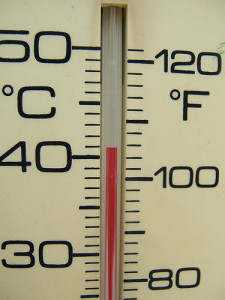By Katrina Marland

Back in February, I wrote about how there is a part of every forest ecosystem that is important for us not to overlook: soil. As active as trees are in absorbing and storing carbon, the soil they’re rooted in can play a similar role, storing CO2-loaded debris like leaves and branches that litter the forest floor. Microbes in the soil consume the carbon, which is then released back into the atmosphere. As long as the microbes work at a normal rate, the amount of carbon stored in the soil far outpaces the carbon that is released. I bring this up because this week, forest soils have been making headlines again.
A team of scientists at UC Irvine has put together a study, recently published in the Proceedings of the National Academy of Sciences, on the role that soil could play in climate change — and vice versa. They wanted to know what effect an increase in temperature would have on the rate of activity in forest soils, so they set up a series of experiments in forests in Wisconsin and North Carolina. They found that heating the soil in these forests by 10 or 20 degrees significantly sped up the natural process and caused the soil to release carbon dioxide up to eight times faster than normal. Even carbon that had been locked in the soil for decades, which scientists thought would be less susceptible to warmer temperatures, was released during the experiments. These findings indicate a potential feedback loop between forest soils and climate change. As global temperatures increase, the soils could release more CO2 into the atmosphere, further contributing to warmer temperatures, and on and on in a vicious cycle. The forests of the northeastern United States — many of which were once farmland and are thought to contain nearly 26 billion tons of carbon — could be a particularly dangerous addition to this cycle of warming soil.
Now, I’ll grant you that a 10-degree increase in global temperatures seems like a heck of a lot, much less a 20-degree increase. But if recent weather hasn’t been enough of a sign — the National Oceanic and Atmospheric Administration recently stated this spring was the warmest on record — what about the last 100 years’ worth of weather info? Just yesterday, the group Climate Central released a new interactive map showing the average temperatures in each state over the past century using data from the National Climatic Data Center. The numbers gets particularly interesting after the 1970 mark, and some of the information on individual states may surprise you. Minnesota, for instance, has seen the third-fastest increase of its average temperatures. Some states show average temperatures increasing much faster than the rest, while others seem to be experiencing only a slow increase. But no matter where you are, you don’t have to look at the map very long to see that the mercury is rising.
